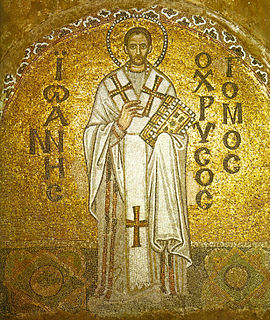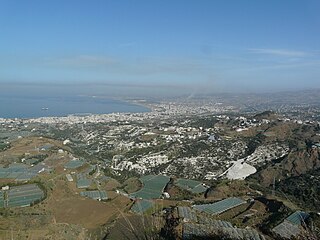
In Christianity, an archbishop is a bishop of higher rank or office. In some cases, such as the Lutheran Church of Sweden and the Church of England, the title is borne by the leader of the denomination. Like popes, patriarchs, metropolitans, cardinal bishops, diocesan bishops, and suffragan bishops, archbishops are in the highest of the three traditional orders of bishops, priests, and deacons. An archbishop may be granted the title or ordained as chief pastor of a metropolitan see or another episcopal see to which the title of archbishop is attached.

Apollonia was an ancient Greek city located on the right bank of the Aous river. Its ruins are situated in the Fier County, next to the village of Pojani (Polina), in modern-day Albania. Apollonia was founded in 588 BCE by Greek colonists from Corfu and Corinth, on a site where native Illyrian tribes lived, and was perhaps the most important of the several classical towns known as Apollonia. Apollonia flourished in the Roman period and was home to a renowned school of philosophy, but began to decline in the 3rd century AD when its harbor started silting up as a result of an earthquake. It was abandoned by the end of Late Antiquity.
The Roman Catholic Archdiocese of Tunis is a Roman Catholic diocese in Tunis, Tunisia. It was founded on 10 November 1884 under the name "Archdiocese of Carthage", with territory corresponding to that of the then French protectorate of Tunisia. On 9 July 1964, it became a territorial prelature under the ecclesiastical title of Prelature of Tunis. It was made a diocese, keeping the name of Tunis, on 31 May 1995, and raised to the rank of archdiocese on 22 May 2010.

Antioch on the Maeander or Antiochia on the Maeander, earlier Pythopolis, was a city of ancient Caria, in Anatolia. The city was situated between the Maeander and Orsinus rivers near their confluence. Though it was the site of a bridge over the Maeander, it had "little or no individual history". The scanty ruins are located on a hill a few km southeast of Kuyucak, Aydın Province, Turkey, near the modern city of Başaran, or the village of Aliağaçiftliği. The city already existed when Antiochus I enlarged and renamed it. It was home to the sophist Diotrephes.

Barca, also called Barce, was an ancient city and former bishopric, which survives as both a Latin Catholic and an Orthodox titular see.

Paltus or Paltos is a ruined city. It was also a bishopric, a suffragan of Seleucia Pieria in the Roman province of Syria Prima, that, no longer being a residential see, is included in the Catholic Church's list of titular sees.
Berissa was a city in the late Roman province of Pontus Polemoniacus, in Asia Minor, which Kiepert and W. M. Ramsay have identified with the modern village of Baulus, 25 kilometres south-west of Tokat.
Dometiopolis was a city in the Roman province of Isauria in Asia Minor. Its ruins are found in the village of Katranlı, formerly Dindebul.

Byllis or Bullis or Boullis (Βουλλίς) was an ancient city located in the region of Illyria. The remains of Byllis are situated north-east of Vlorë, 25 kilometers from the sea in Hekal, Fier County, Albania.

Heraclea Cybistra, under the name Cybistra, had some importance in Hellenistic times owing to its position near the point where the road to the Cilician Gates enters the hills. It lay in the way of armies and was more than once sacked by the Arab invaders of Asia Minor. Three hours’ ride south is the famous "Hittite" rock relief of a lynx, representing a king adoring a god. This was the first "Hittite" monument discovered in modern times.

Nicopolis was a Roman colony in Lesser Armenia founded by Pompey in 63 BC after conquering the Kingdom of Pontus in the third Mithridatic War. It became part of the Roman province of Armenia Prima. Today, the city of Koyulhisar in northeastern Turkey occupies the site.
Polybotus or Polybotos, modern Bolvadin, Turkey, was a city in the Roman province of Phrygia Salutaris. The city's bishop was a suffragan of Synnada.
Cotenna was a city in the Roman province of Pamphylia I in Asia Minor. It corresponds to modern Gödene, near Konya, Turkey.
Dausara is a former residential episcopal see in the Roman province of Osrhoene, a suffragan of Edessa. It is now a titular see of the Catholic Church.
Trapezopolis was a city in the late Roman province of Phrygia Pacatiana Prima.

Baniyas is a city in Tartous Governorate, northwestern Syria, located 55 km south of Latakia and 35 km north of Tartous.
The episcopal see of Carthage, the city restored to importance by Julius Caesar and Augustus, in which Christianity was firmly established by the 2nd century, was the most important in the whole of Roman Africa and continued as a residential see even after it had fallen to the Muslim conquest, until the start of the second millennium.















